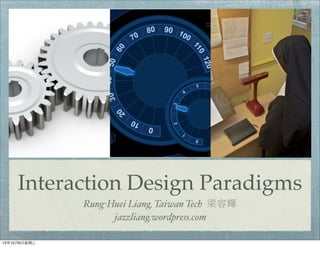More Related Content More from Rung-Huei Liang More from Rung-Huei Liang (12) 2. Paradigms
What is Paradigm?
Paradigm shift: Thomas Kuhn (1962)
What are paradigms in HCI and Interaction Design?
Kuhn, T. (1962) The Structure
of Scientific Revolutions
13年10月9⽇日星期三
4. 派典的架構
認識論 (epistemology) 關心的是”人類如何認識其外在世界”, 也就是”人與知識的關
係是什麼”
本體論 (ontology) 關心的是: 人作為一個研究者, 必然要思考, 這個被研究的對象, 其
本體是什麼?
方法論 (methodology) 所關心的: 人應該用什麼方法來認識他相信是可以認識的對
象?
運用這樣的方法論, 有什麼實際可操作的方法 (methods), 工具 (toolkits) 來獲取知識
13年10月9⽇日星期三
6. 四大派典
實證主義 (positivism)
後實證主義 (post positivism)
批判理論 (critical theory)
建構主義 (constructivism)
每個派典都應該具體呈
現三個層次:
本體論 (ontology)
認識論 (epistemology)
方法論 (methodology)
13年10月9⽇日星期三
9. Paradigm Positions 1. Guba, E.G., & Lincoln,
Y.S., Competing Paradigms
in Qualitative Research
2. jazzliang’s thinking
http://jazzliang.wordpress.com
13年10月9⽇日星期三
11. The 3 Paradigms in HCI
(1) 工程/人因派典 (engineering/human factors), 聚焦在人與機器調適的最佳化
(2) 認知科學派典 (cognitive science), 強調人類心智模型在人機互動中的重要性, 互
動過程被視為資訊溝通 (information communication)
(3) 第三派典/現象學矩陣 (phenomenological matrix), 將互動視為一種現象學情境
(phenomenologically situated)
Harrison, S. et al.
(2007) The Three
Paradigms of HCI
(Rejected papers by
ACM SIGCHI)
13年10月9⽇日星期三
12. The 3rd Paradigm
Harrison 等人所提的 HCI 第三派典, 其實是呼應 Paul Dourish 的現象學取徑來研究
體現互動 (embodied interaction)
強調胡塞爾所提的生活世界 (life world), 作為一種前科學功能世界的概念
重視意義創造 (meaning-making), 理解 (understanding), 意圖性 (intentionality)
13年10月9⽇日星期三
13. Three Waves in HCI
(1)第一波, 實驗認知心理學 (experimental cognitive psychology), 來自於對人因工
程與軟體工程的批判, 並認為應將人視為主動認知的個體
(2) 第二波, 電腦支援協同工作 (CSCW), 主要是對第一波的批判, 主張應該補捉使用
者的社會認同, 使用者活動的人際關係, 以及運算科技的社會脈絡
(3) 非工作設定與主題 (non-work settings and topics), 包含真實生活經驗 (lived-
experience)(注意: 此語極端的現象學意味), 親密 (intimacy), 愉悅 (pleasure), 體現
(embodiment)
Bowers, J. (2012) The
logic of annotated
portfolios: communicating
the value of 'research
through design'
13年10月9⽇日星期三
14. 雖然 Bowers 的分類和 Harrison 等人不完
全相同, 但是, 他們一致認為互動設計的最新
的派典, 是現象學趨向的, 是 Paul Dourish
早在 2001 年就說過的.
13年10月9⽇日星期三
15. 所研究現象
科學: 自然世界 (the nature world)
人文: 人類經驗 (human experience)
設計: 人造世界 (artificial world)
Cross, N. (2007)
Designerly Ways of
Knowing
13年10月9⽇日星期三
16. 採用方法
科學: 控制的實驗, 分類, 分析 (controlled experiment, classification, analysis)
人文: 類比, 譬喻, 評估 (analogy, metaphor, evaluation)
設計: 建模, 式樣構成, 合成 (modelling, pattern-formation, synthesis)
13年10月9⽇日星期三
17. 價值
科學: 客觀, 理性, 中立, 真理 (objectivity, rationality, neutrality, truth)
人文: 主觀, 想像, 承諾, 正義(subjectivity, imagination, commitment, justice)
設計: 實用性, 獨創性,移情, 適當性 (practicality, ingenuity, empathy,
appropriateness)
13年10月9⽇日星期三
18. Consumer Needs
(1) 功能性 (functionality)
(2) 易用性 (usability)
(3) 愉悅性 (pleasure)
Jordan, P. (2000)
Designing Pleasurable
Products
13年10月9⽇日星期三
20. 3 paradigms & 3 needs
(1) 第一派典是工程/人因派典 (engineering/human factors), 聚焦在人與機器調適的
最佳化, 工程師與人因科學家努力達成功能性 (functionality);
(2) 第二派典是認知科學派典 (cognitive science), 強調人類心智模型在人機互動中的
重要性, 互動過程被視為資訊溝通 (information communication), 認知科學家與實驗
心理學家感興趣於如何增進易用性 (usability);
(3) 第三派典是現象學矩陣 (phenomenological matrix), 將互動視為一種現象學情境
(phenomenologically situated), 將使用者重新視為完整的, 複雜的, 情境的, 意義建
構的存在體, 呼應著 Jordan 無法仔細分類, 但勉強給出一個名字: 愉悅性 (pleasure).
13年10月9⽇日星期三
22. 技術的意義現身
任何產品都有意義, 然而許多公
司並不關心如何創新意義, 反倒
致力於了解消費大眾如何賦予
事物意義, 卻赫然發現那項意
義, 竟是競爭對手設計的創新之
舉.
意義創新的過程, Verganti 提
出了"找到關鍵詮釋
者" (interpreter) , 以及加入與
掌握"設計論述" (design
discourse) 等方法. 這些熟悉的
術語, (意義創新, 詮釋, 論述…)
都在在暗示, Verganti 是第三派
典的鼓吹者.
Roberto Verganti ,
設計力創新
13年10月9⽇日星期三
23. We would expect that calling out the underlying paradigm will become a standard
part of every publication in our field.
我們期待每一個互動設計的論文發表, 都應該將"喚出底層派典" 視為一項標準工作.
13年10月9⽇日星期三

